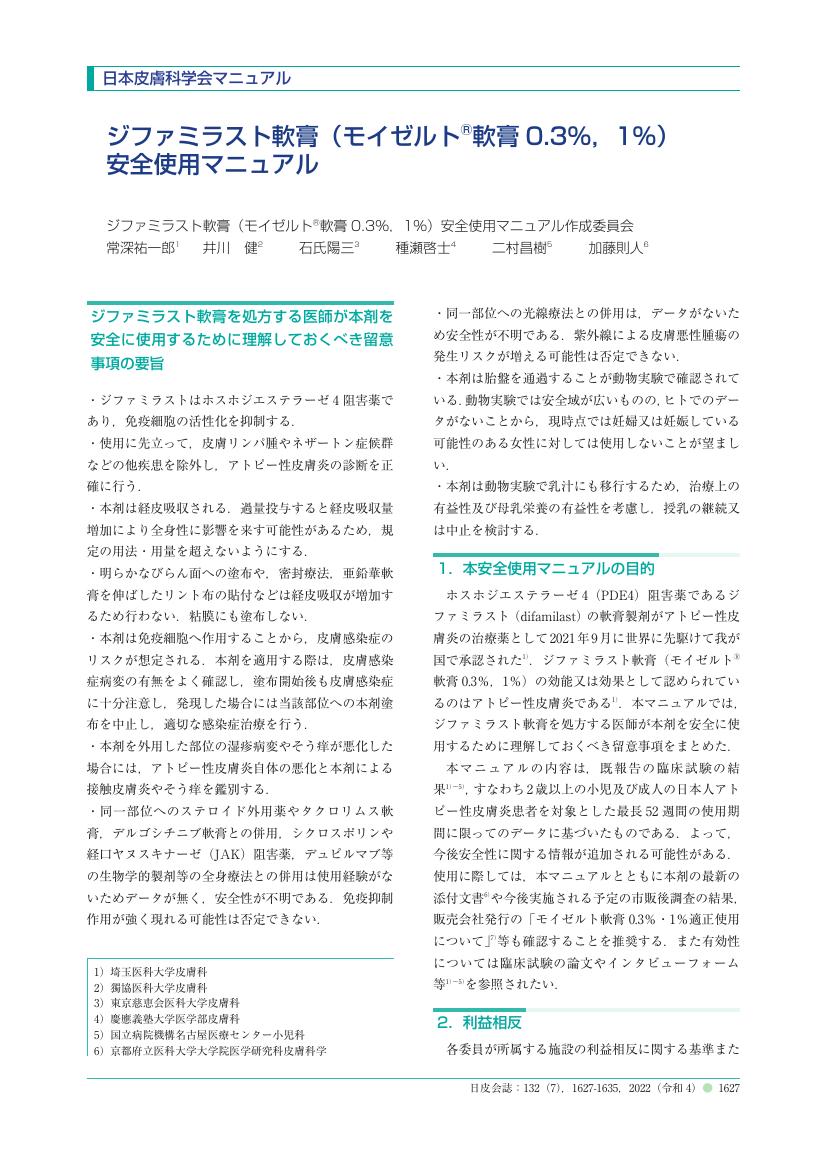2 0 0 0 OA 3.アトピー性皮膚炎・かゆみと脳機能
- 著者
- 石氏 陽三
- 出版者
- 一般社団法人 日本アレルギー学会
- 雑誌
- アレルギー (ISSN:00214884)
- 巻号頁・発行日
- vol.66, no.6, pp.777-782, 2017 (Released:2017-07-12)
- 参考文献数
- 28
- 被引用文献数
- 2
2 0 0 0 OA ジファミラスト軟膏(モイゼルトⓇ軟膏0.3%,1%)安全使用マニュアル
- 著者
- ジファミラスト軟膏(モイゼルトⓇ軟膏0.3%1%)安全使用マニュアル作成委員会 常深 祐一郎 井川 健 石氏 陽三 種瀬 啓士 二村 昌樹 加藤 則人
- 出版者
- 公益社団法人 日本皮膚科学会
- 雑誌
- 日本皮膚科学会雑誌 (ISSN:0021499X)
- 巻号頁・発行日
- vol.132, no.7, pp.1627-1635, 2022-06-20 (Released:2022-06-20)
- 参考文献数
- 16
1 0 0 0 5D itch scale日本語版の作成
- 著者
- 江畑 俊哉 石氏 陽三 佐伯 秀久 中川 秀己
- 出版者
- 公益社団法人 日本皮膚科学会
- 雑誌
- 日本皮膚科学会雑誌 (ISSN:0021499X)
- 巻号頁・発行日
- vol.125, no.5, pp.1035-1040, 2015-04-20 (Released:2015-04-23)
- 参考文献数
- 13
瘙痒性皮膚疾患の治療効果判定においては,検証された基準に基づいてかゆみが評価されるべきである.かゆみの評価尺度としてVisual Analogue Scale(以下VAS)などの信頼性,妥当性が検証されている中,5D itch scale(以下5D)が開発された.5Dはかゆみの持続時間,強さ,経過,悪影響,身体分布を評価して点数化する自記式質問票で,著者らは5Dの日本語版を,順/逆翻訳,プレテストを経て作成した.5D日本語版により,かゆみの複数の側面を簡便に評価し定量化できることが期待される.
1 0 0 0 OA 痒みと掻破の脳伝達機構
- 著者
- 石氏 陽三
- 出版者
- 日本疼痛学会
- 雑誌
- PAIN RESEARCH (ISSN:09158588)
- 巻号頁・発行日
- vol.33, no.4, pp.315-322, 2018-12-28 (Released:2019-03-29)
- 参考文献数
- 34
- 被引用文献数
- 1
Itch is defined as an unpleasant sensation that evokes the desire to scratch. Intractable itch and scratching can affect sleep, mood, and personal relationships, significantly reducing quality of life of the chronic pruritic diseases such as atopic dermatitis. Pruritogens activate certain receptors on small itch–selective unmyelinated C fibers. Peripheral itch stimuli are transmitted by sensory neurons to the spinal cord dorsal horn. After undergoing processing in the spinal cord, itch signals are conveyed through the spinothalamic tract to the thalamus and through the spinoparabrachial pathway to the parabrachial nucleus. Itch processing activates many brain areas such as the prefrontal cortex (PFC), supplementary motor area (SMA), premotor cortex (PM), primary motor cortex (MI), primary somatosensory cortex (SI), parietal cortex, cingulate cortex, precuneus, opercular cortex (OPC) including the secondary somatosensory cortex (SII) and insular cortex (IC), claustrum, basal ganglia including the striatum, thalamus, and cerebellum. Itch was suppressed during and after scratching. It proposed two possible mechanisms by inhibitory circuits of the spinal dorsal horn and descending inhibitory pathway originated from brain such as periaqueductal gray matter (PAG), the raphe nuclei and locus ceruleus. Scratching temporarily relieves itch and can also be rewarding and even addictive. The degree of pleasure obtained by scratching is correlated with itch intensity. In addition, activation of areas of the brain reward system (eg, midbrain and striatum) is observed when an itch is scratched. In the brain, chronic itch modulates activation of particular brain areas, including the anterior cingulate cortex (ACC), posterior cingulate cortex (PCC), and PFC; alternates functional brain connectivity; and can decrease the gray matter in itch–relating cortical areas, including the PFC and precuneus. These can play a role in processing the chronification of itch. In patients with atopic dermatitis, histamine–induced itch robustly activates the ACC and PFC. The degree of activation of these areas is closely correlated with disease activity. In addition, the degrees of activation of the PCC and precuneus are greater than those of healthy subjects. These changes might lead to neural sensitization to itch in the brain. One of the mechanisms of severe itch is skin hypersensitivity. Scratch usually inhibit itch in healthy subjects, however, it aggravates itch in the chronic pruritic diseases. This phenomenon is called ‘itch–scratch cycle’. Recent improved brain imaging studies demonstrate the brain mechanisms of chronic itch condition. A higher activity during scratching in chronic itch patients, versus healthy controls, was noted in brain regions related to motor control and motivation to act. The objectives of this review will be to address the new insight of brain mechanisms of chronic itch and the future prospect for the development of new drugs.

